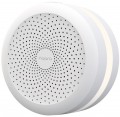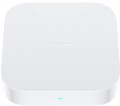Communication protocol with sensors
This parameter directly affects the compatibility of additionally connected devices, including complete sensors. Such devices must have the same protocol, otherwise normal operation will be impossible. As for specific options, modern alarm kits can use both common
Wi-Fi and
Bluetooth standards, as well as specialized protocols - most often
Z-Wave,
Zigbee or
Jeweller. Here is a more detailed description of each of these standards:
— Wi-Fi. A technology used mainly for building wireless computer networks, and more recently — also for direct communication between individual devices. The 2.4 GHz or 5 GHz range is most often used for communication. In the case of wireless sensors, one of the advantages of Wi-Fi is that it is a generally accepted standard; due to this, many sensors with this type of communication can work without special equipment — they are able to connect to regular wireless routers or even individual devices such as laptops and tablets (some models even allow sending notifications via the Internet, through the same router). However, such versatility has a downside: Wi-Fi has no additional optimization for working with wireless sensors. As a result, such communication is inferior to specialized protocols in terms of overall reliability, special functionality and energy efficiency. So
...this type of communication is typical mainly for devices designed for simple conditions of use — such as climate temperature/humidity sensors for smart home systems.
— Bluetooth. Another common wireless communication standard. It operates in the 2.4 GHz range; unlike Wi-Fi, it is used only for direct communication between devices. It is also poorly suited for professional use (in particular, the response delay can reach 2-3 seconds), and therefore is mainly found in household-specific sensors designed for communication to smartphones/tablets or smart home systems. The Bluetooth LE protocol, supported by Bluetooth modules of version 4.0 and higher, is most often used for communication: it is specially designed for miniature devices with small capacity of built-in batteries, allows data transmission with very low energy costs and at the same time provides a range of up to 100 m.
— Z-Wave. A wireless communication standard specifically designed for automation and control systems, including alarms and smart homes. Along with the one described below, Zigbee is one of the generally accepted protocols used in such systems. Such communication is simple and inexpensive to implement, while being quite functional and practical. It provides for the transmission of the simplest and shortest control commands, which helps save energy, and operates in the range of up to 1 GHz, due to which it is not susceptible to interference from Wi-Fi and Bluetooth devices. In addition, in Z-Wave-based networks, it is possible to use a MESH-type topology - when each individual device is also a full-fledged repeater of signals from other components of the system. Devices in networks of this type can choose any signal route, through any number of intermediate nodes, depending on the situation. For example, if direct communication between two nodes for some reason turned out to be impossible, the data will be sent "bypassing" through other network devices, and the system will automatically determine the most optimal route. This makes it easy to organize large networks with a large number of devices and a large coverage area.
— Zigbee. Another communication protocol created for automation systems (including smart home), alarms, industrial control, etc. In many ways, it is similar to the Z-Wave described above: it allows you to transmit control signals with low energy costs, as well as create MESH networks with signal direction through several nodes and automatic selection of the optimal route taking into account the current situation in the network. The main differences between Zigbee and Z-Wave are high protection of communication channels from hacking, as well as the ability to ensure high response speed. The downside of these advantages is the higher cost of implementing this protocol. Therefore, there are slightly fewer devices for this communication standard than for Z-Wave.
— Jeweller. A proprietary communication protocol developed by Ajax Systems. The company specializes in alarms, and this protocol was originally created specifically for such systems — this is what determines its advanced characteristics. In particular, Jeweller provides a communication range of up to 2 km with very low energy costs, has high-class protection against hacking, allows you to change frequencies when trying to jam the operating range and supports the simultaneous communication of up to 150 devices per gateway. However, the main disadvantage of this protocol is that its use is limited to devices from one manufacturer. So it makes sense to purchase models with Jeweller support if the house uses (or plans to use) an alarm system from Ajax Systems.
— Own frequency. In the context of alarms and HUBs, this parameter refers to the own frequency at which wireless data exchange between the protection system links is ensured. Its specific value is determined by the device manufacturer, but the most common options are 433–434 MHz and 868 MHz. Using the own frequency improves the reliability and safety of the protection system, since it reduces the likelihood of interference from other wireless devices operating at close frequencies. When choosing based on this parameter, it is important to consider equipment compatibility, standards, and licensing requirements (in order to avoid potential violations of the law).Max. wireless sensors
The number of wireless sensors that can be simultaneously connected to the central unit (if this connection format is supported — see "Connecting sensors"). This number, by definition, is not less than the number of wireless zones (see the relevant paragraph).
Note that even the most modest modern systems support 6 – 8 wireless sensors, in the most advanced models this number can exceed 100. So you have to pay attention to this parameter mainly in cases where you need to organize a very extensive alarm system.
Siren
The presence of its own siren in the standard configuration of the set.
The siren provides an audible and, in some models, a light alarm; sometimes this is enough to stop an encroachment on a protected object or to attract the attention of security / law enforcement officers. Such equipment can also be purchased separately (if there is a corresponding output, see "Control panel options"). However, in most cases it is more convenient to buy a system that was originally equipped with a siren: this will allow you not to worry about compatibility, and complete sirens usually give out more than a decent number of decibels (see "Siren volume").
Operating temperature
The air temperature range in which the alarm components maintain normal operation.
This parameter is important first of all in cases where the alarm is planned to be used outdoors or in unheated rooms. Particular attention in such cases should be paid to whether the system can work
at sub-zero temperatures. If we are talking about room temperatures (plus or minus), then you can’t really look at the claimed temperature range — almost any alarm is suitable for such conditions.

